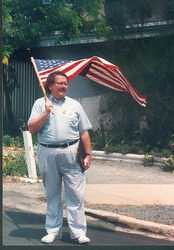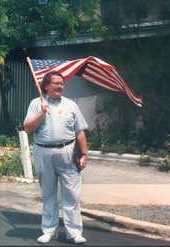Wednesday, February 14, 2001
UNC removal of magnolia for utilities irks residents
Chapel Hill Herald, Feb. 14, 2001
CHAPEL HILL - For three decades, Ken Jackson has enjoyed the view of the UNC campus he has from his jewelry store window.
Thus, the recent removal of a towering magnolia tree near Franklin Street has saddened Jackson and others who treasure the beauty of the campus.
"I was very heartsick," said Jackson, who owns Franklin Street's Wentworth & Sloan. "I've looked at that tree every day for the last 30 years. It's a loss."
The tree came down about two weeks ago, the result of a new campus building project. It was in the way and its destruction couldn't be avoided, said UNC officials, themselves sorry to see the tree go.
Jackson, for one, accepts the university's explanation that the tree had to be removed to install a utility line. But others in town aren't so easily convinced.
"It seems to me they could have planned better," said Joe Herzenberg, a town resident who, as a member of the Town Council in the late 1980s, led a town task force on tree protection. "They took the shortest distance between two points for this utility line. If they had gone 20 yards to the east, closer to Battle Hall, they could have avoided the roots of the tree."
The tree stood back from the street just west of Battle-Vance-Pettigrew. It was slated to be preserved, but construction on a new Institute for the Arts and Humanities nearby took an unplanned twist. To hook the new institute into an existing water line on the north side of Franklin Street, construction workers had to build a larger, deeper hole than was originally thought. The hole was needed to bore under Franklin Street to reach the water line. The other option, to tear up Franklin Street and build a new line under it, was less feasible. So, the tree had to be removed.
"I really had nowhere to go on this," said Kirk Pelland, UNC's grounds director. "The tree couldn't be saved."
And university officials say there's nothing to Herzenberg's claim that they simply could have moved the path of the utility line slightly, to work around the tree.
"It's not that easy, and you have to weigh your disruptions," said Anna Wu, UNC's associate director for facilities planning and design. "It proved to be the best alternative."
But the decision has left Herzenberg unsatisfied, a sentiment he expressed in a recent letter penned to UNC Chancellor James Moeser. The decision, he said, points to a larger issue involving the university's philosophy concerning campus development.
"The big point is that the university has its eye on master plans, on campus and for the Horace Williams property," he said. "They tend to be not as careful about the smaller points, which are also important - in this case, the tree."
But facilities planners say the university does make those so-called "smaller points" a priority and pledge to beautify the area around the institute once construction finishes. Bruce Runberg, associate vice chancellor for facilities services, has pledged to plant a new magnolia tree nearby to replace the old one.
"Our intention is to go back and re-landscape that area," Wu said. "We will restore that area."
Jackson, the jewelry store owner, accepts the price of progress. Still, he's sorry to see the old magnolia go. "It was an older tree," he said. "The older I got, the greater appreciation I had for older things. It was a beautiful tree."
CHAPEL HILL - For three decades, Ken Jackson has enjoyed the view of the UNC campus he has from his jewelry store window.
Thus, the recent removal of a towering magnolia tree near Franklin Street has saddened Jackson and others who treasure the beauty of the campus.
"I was very heartsick," said Jackson, who owns Franklin Street's Wentworth & Sloan. "I've looked at that tree every day for the last 30 years. It's a loss."
The tree came down about two weeks ago, the result of a new campus building project. It was in the way and its destruction couldn't be avoided, said UNC officials, themselves sorry to see the tree go.
Jackson, for one, accepts the university's explanation that the tree had to be removed to install a utility line. But others in town aren't so easily convinced.
"It seems to me they could have planned better," said Joe Herzenberg, a town resident who, as a member of the Town Council in the late 1980s, led a town task force on tree protection. "They took the shortest distance between two points for this utility line. If they had gone 20 yards to the east, closer to Battle Hall, they could have avoided the roots of the tree."
The tree stood back from the street just west of Battle-Vance-Pettigrew. It was slated to be preserved, but construction on a new Institute for the Arts and Humanities nearby took an unplanned twist. To hook the new institute into an existing water line on the north side of Franklin Street, construction workers had to build a larger, deeper hole than was originally thought. The hole was needed to bore under Franklin Street to reach the water line. The other option, to tear up Franklin Street and build a new line under it, was less feasible. So, the tree had to be removed.
"I really had nowhere to go on this," said Kirk Pelland, UNC's grounds director. "The tree couldn't be saved."
And university officials say there's nothing to Herzenberg's claim that they simply could have moved the path of the utility line slightly, to work around the tree.
"It's not that easy, and you have to weigh your disruptions," said Anna Wu, UNC's associate director for facilities planning and design. "It proved to be the best alternative."
But the decision has left Herzenberg unsatisfied, a sentiment he expressed in a recent letter penned to UNC Chancellor James Moeser. The decision, he said, points to a larger issue involving the university's philosophy concerning campus development.
"The big point is that the university has its eye on master plans, on campus and for the Horace Williams property," he said. "They tend to be not as careful about the smaller points, which are also important - in this case, the tree."
But facilities planners say the university does make those so-called "smaller points" a priority and pledge to beautify the area around the institute once construction finishes. Bruce Runberg, associate vice chancellor for facilities services, has pledged to plant a new magnolia tree nearby to replace the old one.
"Our intention is to go back and re-landscape that area," Wu said. "We will restore that area."
Jackson, the jewelry store owner, accepts the price of progress. Still, he's sorry to see the old magnolia go. "It was an older tree," he said. "The older I got, the greater appreciation I had for older things. It was a beautiful tree."
Subscribe to:
Post Comments (Atom)







No comments:
Post a Comment